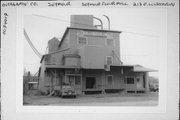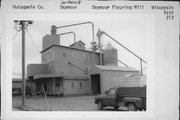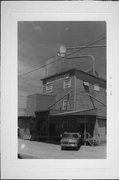Property Record
213 E WISCONSIN ST
Architecture and History Inventory
| Historic Name: | Bickhart Flour Mill |
|---|---|
| Other Name: | Seymour Flour Mill |
| Contributing: | |
| Reference Number: | 74017 |
| Location (Address): | 213 E WISCONSIN ST |
|---|---|
| County: | Outagamie |
| City: | Seymour |
| Township/Village: | |
| Unincorporated Community: | |
| Town: | |
| Range: | |
| Direction: | |
| Section: | |
| Quarter Section: | |
| Quarter/Quarter Section: |
| Year Built: | 1907 |
|---|---|
| Additions: | |
| Survey Date: | 1981 |
| Historic Use: | mill |
| Architectural Style: | Astylistic Utilitarian Building |
| Structural System: | |
| Wall Material: | Clapboard |
| Architect: | |
| Other Buildings On Site: | |
| Demolished?: | No |
| Demolished Date: |
| National/State Register Listing Name: | Not listed |
|---|---|
| National Register Listing Date: | |
| State Register Listing Date: |
| Additional Information: | See HAER form. OAHP INVENTORY 03/1981): The original building of the Seymour Flour Mill is a three-story wood structure with a combined limestone, stone, metal and wood foundation. The roof is gabled and the windows have plain molding with slip sills. Newer additions (post-1945) have been added to the original mill's north and east sides and contain a garage and loading apparatus. The floor plan is irregular and the entire structure, including the newer additions, measures 112 feet long and 48 feet wide. The earliest date the Seymour Flour Mill can be traced to is 1907, when it wwas qurchased from a Mr. Bickhart by Alfred G. Keune. At that time the mill produced wheat and rye flour and it was a three-man operation. About 1925 the mill began shifting operations from flour to that of a retail animal feed mill, and in time abandoned flour making altogether. In the mid 1930s Milton A. Keune purchased the business form his father. In 1964, Robert Mill of Rt. 3, Seymour, purchased the company, and in turn sold it to the present owner, Ray Rottier, in 1971. The mill is operated as a year round custom mix, retail animal feed mill and employs about ten people (operations were seasonal until about 1976). Grain is mixed with salt, vitamins, minerals and protein and then sold to area farmers. The grain mix for each farmer is determined by running forage analysis results, done in conjunction with a lab in Madison, through a computer. None of the original flour-making equipment is on site now. The plant does contain machinery to grind certain grains and to mix and balance feed ratios. Some of the product is bagged, some is loaded into trucks. |
|---|---|
| Bibliographic References: | (A.) Marion Otto, daughter of Alfred Keune, interviewed by Bill Meindl, date of interview unknown (ca. 1981). (B.) THE CENTENNIAL REVIEW OF SEYMOUR, 1968, p. 51, housed in the Local History department of the Brown County Library. (C.) Ray Rottier, owner, interviewed by Bill Meindl, date of interview unknown (ca. 1981). |
| Wisconsin Architecture and History Inventory, State Historic Preservation Office, Wisconsin Historical Society, Madison, Wisconsin |



